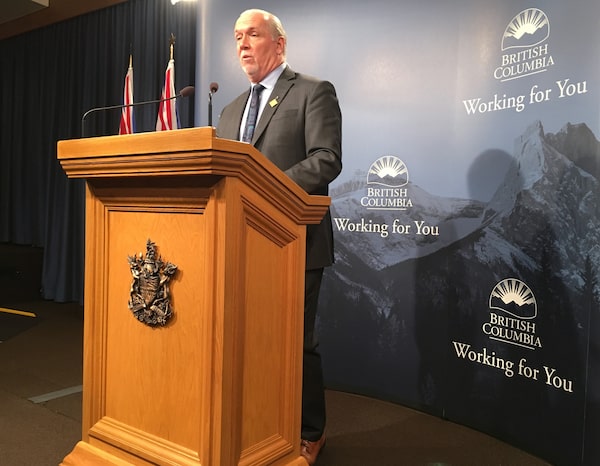
If B.C. Premier John Horgan, seen here on Nov. 28, 2019, and the NDP want to win a majority government in the 2021 election, they need to appeal to rural voters as well.Dirk Meissner/The Canadian Press
Members of the BC Liberal Opposition worked up a lather last week about an internal e-mail they found, sent by a ministerial assistant to his counterparts, that bluntly outlines the political landscape in rural B.C.
The Opposition focused on a reference in the e-mail to the rural economic dividend program that was established when the Liberals were in power, described in the e-mail as “slush fund.” That fund was suspended by the NDP government, which has created its own funding program instead.
But the correspondence reveals something bigger: It is the story of how the NDP set out to regain the trust of voters in rural B.C.
Tim Renneberg is a senior political aide to Doug Donaldson, the Minister of Forests, Lands, Natural Resource Operations and Rural Development. In February, 2018, Mr. Renneberg sent the e-mail to his colleagues across government, announcing a committee of political aides to co-ordinate rural affairs.
“The goal of the committee would be to strategize, plan and co-ordinate government announcements to make sure that rural BC knows that we have their back and that we are taking rural matters seriously,” he wrote. “To be candid, a look at the map will show why we need to get rural development right.”
What does the map show?
When the NDP returned to power in 2017 after 16 years in opposition, they owed a debt to urban British Columbians for their change in circumstances, picking up just enough seats in Metro Vancouver to form a minority government in partnership with the Greens. But on the electoral map, the Liberals are the party of rural B.C.
Minority government is a better position than opposition, but the NDP has higher ambitions. To win a majority government in the 2021 election, they need to appeal to rural voters as well.
That job has become far harder since Mr. Renneberg began his task 21 months ago. The forest sector that is the lifeblood of hundreds of rural communities appears to be in free fall. Mr. Donaldson has watched mill after mill shuttered on his watch.
The Liberals lay the blame at the feet of the NDP, saying this government has ignored forestry workers, and has failed the forest sector.
“British Columbia’s forest industry is in a crisis. Mass layoffs and shutdowns are announced daily,” said Liberal MLA Shirley Bond, whose riding of Prince George-Valemount is at the centre of the downturn. “What workers want, what families need, is support and action from this government.”
There were about 55,000 people working in the province’s lumber mills in 2018, and since then, roughly one in 10 workers has experienced temporary or permanent job loss. Fourteen mills have reduced shifts. Nine mills have curtailed operations – they may reopen, or they may not. Four mills have closed indefinitely; five more have closed permanently.
Mr. Donaldson, in an interview, said a lot of good work came out of the Renneberg process. It has led to investments in hospitals, schools and housing in rural communities. Those investments don’t just make a better community, he said, but they create jobs in the short term.
“That’s something government can do to try to bridge these cyclical downturns in the resource economy," he said. He emphasizes that there are things beyond government’s control.
Many of the challenges facing the industry are determined outside of B.C.'s borders. International trade disputes, weak markets and volatile prices have all hit at the same time.
In the Interior, the industry has the added problem of a sharp decline in the amount of wood available for harvest, because of the pine beetle epidemic and record-breaking forest fires. The harsh reality is that numerous mill closings were anticipated long before the NDP came to power. The Liberals were warned repeatedly that a major contraction was coming.
The NDP government is offering programs to help displaced workers but, looking down the road to 2021, they will be measured in these communities by a bigger vision: a transition plan that extracts more value from timber and creates a more diversified economic base. Mr. Donaldson, who comes from one of the most rural ridings in the province, says it can be done.
But those solutions won’t be found in the backrooms of the legislature, he said. “It’s people in the communities who will see the solution to what they know needs to be done."
 Justine Hunter
Justine Hunter